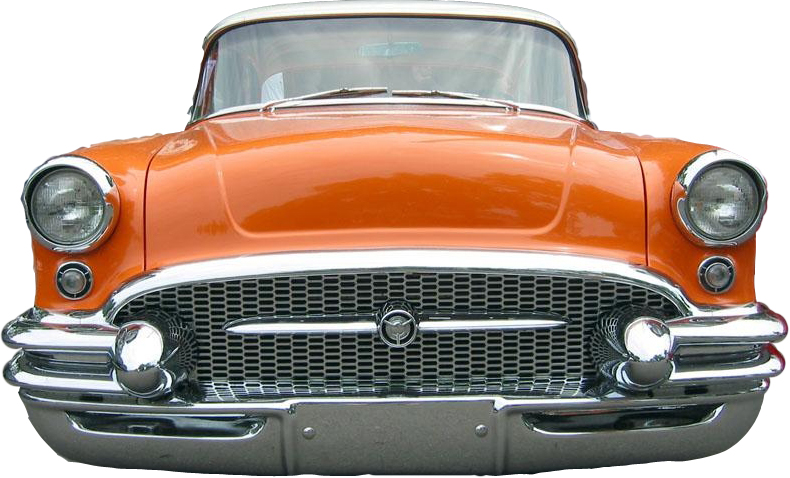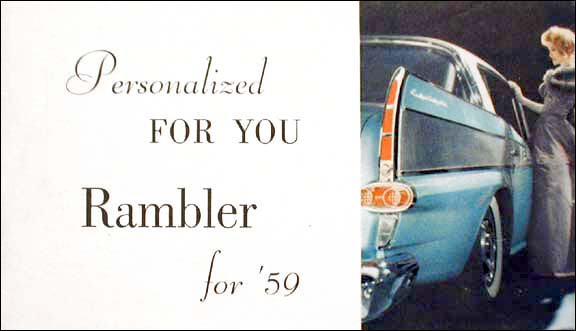The Dinosaur Hunter, Part I
Monday, Apr. 06, 1959
Reprinted Coutesy of Time Magazine
George Wilcken Romney, at 51, is a broad-shouldered, Bible-quoting broth
of a man who burns brightly with the fire of missionary zeal. On the
Lord's Day, and whenever else he can find time, he is a fervent apostle
for the Mormon Church, in which he is a high official. But at all other
times his missionary zeal is best defined by a plaque that hangs in the
walnut-paneled Detroit office where he reigns as boss of American
Motors. A facetious gift from the Cleveland Auto Dealers Association,
it reads: "To George Romney, critic, lecturer, anthropologist, white
hunter of the American dinosaur."
 The American dinosaur, to Romney, is the long, low, chrome-laden U.S.
auto, i.e., any car of his Big Three competitors. Where does he hunt
it? At conventions, Rotary meetings, congressional hearings, wherever
he can find a platform or a soapbox. He closes in on the quarry with a
verbal barrage. Back and forth he rocks, clenching his fists, screwing
his handsome face into an intense mask. Out shoot the words in
evangelical, organlike tones; down flies his big fist to shake the dust
from the table. The American dinosaur, to Romney, is the long, low, chrome-laden U.S.
auto, i.e., any car of his Big Three competitors. Where does he hunt
it? At conventions, Rotary meetings, congressional hearings, wherever
he can find a platform or a soapbox. He closes in on the quarry with a
verbal barrage. Back and forth he rocks, clenching his fists, screwing
his handsome face into an intense mask. Out shoot the words in
evangelical, organlike tones; down flies his big fist to shake the dust
from the table.
He even carries his own props. "This fellow here," he says, suddenly
snatching a green china dinosaur from his briefcase, "is called a
triceratops. He had the biggest radiator ornament in prehistoric
history. It kept getting bigger and bigger until finally he could no
longer hold up his head. He had a wheelbase of nearly 30 feet. The
dinosaur perished because he got too big."
Then Romney pauses dramatically, juts his formidable jaw. "Who," he
challenges, "wants to have a gas-guzzling dinosaur in his garage?" In
the silence that follows, Romney races on to introduce the creature he
would most like to see replace the dinosaur: American Motors' compact
little Rambler.
With inexhaustible energy Romney last year traveled 70,000
miles across the U.S. to preach his message, sometimes sleeping and
eating in his Rambler. He wears an alarm wrist watch to remind himself
when to stop talking, but no one can remember a time when he ever
heeded it. He likes to get up before women's clubs, fix the ladies
accusingly with his blue-grey eyes. "Ladies," he says, wagging his
finger at them, "why do you drive such big cars? You don't need a
monster to go to the drugstore for a package of hairpins. Think of the
gas bills!" No audience is too small for him. Caught in a taxi in the
middle of a St. Louis traffic jam, he lectured the captive driver: "Now
if we all drove small cars, we'd have a lot less trouble like this."
His parting tip as he abandoned the cab and sprinted off on foot: "Next
time try a Rambler."

Recently, when an American Motors executive showed up at an automobile
manufacturers' meeting in place of Romney, a Big Three auto official
asked: "Where's the boss?" Said the substitute: "He's making a speech."
Yawned the Big Three man: "So what else is new?"
Through his talkathon, George Romney has brought off singlehanded one of
the most remarkable selling jobs in U.S. industry. He has taken a
company that only three years ago was on the brink of the grave, the
butt of countless jokes ("Did you hear about the man who was hit by a
Rambler and went to the hospital to have it removed?"), and given it a
new and vibrant lease on life. More remarkable, he has done it all by
selling an "economy" car that, in 1956, actually cost $4 more than the
Big Three's cheapest car (it is now $311 cheaper), and that takes an
expert driver to get the company-boasted gas mileage (more than 30
miles to the gallon). Snorts a General Motors executive: "Romney's been
selling a dream—price and economy—but he's done a helluva good job at
it."
Just as remarkable, Romney has proved a powerful competitor not only
against the Big Three but against a flood of small imported cars, whose
chief selling point is even lower cost and greater economy than the
Rambler. This year the 60-odd foreign cars coming into the U.S. are
expected to account for 560,000 units, or more than 10% of the U.S.
market. But Rambler's sales have risen faster than any of the imports.
Rambler has done so well that it is in fifth place in U.S.
auto sales (after Chevrolet, Ford, Oldsmobile and Pontiac); its share
of the market has risen from 1.6% to 6.2% in two years. This week it
made its 20th successive increase in production in 1½ years. Yet the
public is still ordering Ramblers faster than American Motors can produce
them. Romney is in the midst of a $10 million expansion program that
will lift the company's capacity to 440,000 cars a year.
Click here for part 2
|

